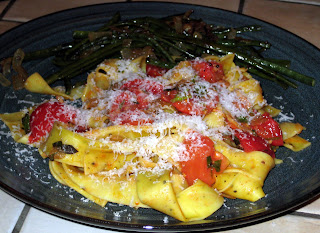By all rights, this should have been a disaster. Bok choy and garbanzo beans clearly don't mix, and I honestly don't understand my fascination with saffron or my inability to keep from throwing it into dishes in which it obviously does not belong. And yet instead of being disastrous, this dish turned out surprisingly well, and even bordered on addictive. Which actually probably explains my obsession with saffron...I tend to throw it in when it a dish is already moving in bizarre directions, and then when it turns out, I associate the resulting deliciousness with the pinch of fiery red strands I couldn't help but toss into the pan.
Serve this over black Forbidden rice or brown jasmine rice.
Ingredients
Olive oil
1 can garbanzo beans, drained and rinsed
A couple generous sprinklings of black mustard seeds
A pinch of saffron, crumbled
1-2 bell peppers (white, red, purple, green, whatever), halved and sliced
1 jalapeno, thinly sliced
1 large clove garlic, pressed
2-4 heads of bok choy, sliced crosswise into one-inch pieces
1/4-1/2 cup veggie broth
Salt & freshly ground black pepper

Heat a generous glug of olive oil in a large, wide pan over high heat. When hot, add the garbanzos and shake the pan to coat them with olive oil. Let sit for a minute, then shake again. Wait until a few start to pop, shake to stir, and wait again, adding a little more olive oil if necessary to keep the bottom of the pan coated. After several minutes, they should start to turn a little golden brown.
Next, add the mustard seeds and saffron, stir a few times, then add the peppers and cook, stirring, for a minute or two. Turn the heat down and add the garlic, wait a few seconds, then stir to combine. Add the bok choy, a pinch of salt, and 1/4 cup of broth, cover the pan, and let the greens steam for a minute or two until you can get a spatula under them to mix them in with the garbanzos. If the pan is dry, add a little more broth, stir, and cover to steam again for another minute or until greens have started to wilt. Uncover, stir-fry for another minute or so, sprinkle with salt and pepper, and serve.
Serves 2-3.















